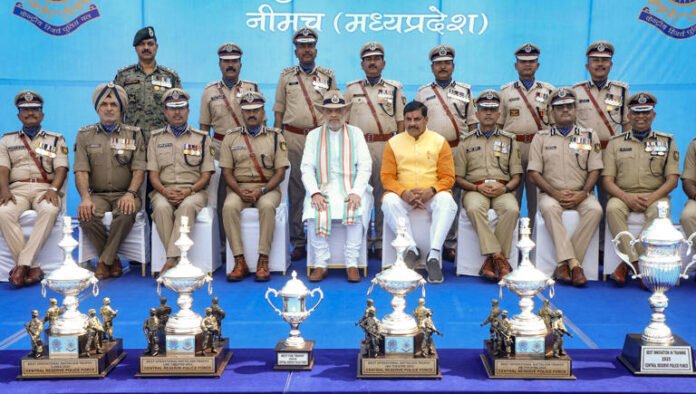Union Home Minister Amit Shah has declared the Central Reserve Police Force (CRPF) as the “backbone” of the Indian government’s ambitious mission to eliminate Naxalism by March 2026. Speaking at a national security conference, Shah praised the CRPF’s tireless efforts and critical role in the ongoing battle against the Maoist insurgency that has plagued parts of the country for decades.
Naxalism, a form of left-wing extremism, has been one of India’s most persistent internal security challenges. Originating in the late 1960s, the Naxalite movement, led by Maoist ideologies, primarily operates in the so-called Red Corridor, which stretches across states like Chhattisgarh, Jharkhand, Odisha, Bihar, Madhya Pradesh, and Maharashtra. Over the years, the insurgency has caused significant loss of life, disrupted development, and hindered the stability of regions that are already among the country’s most underdeveloped.
The CRPF’s Pivotal Role in Combating Naxalism
The CRPF, which is the largest paramilitary force in India, has been at the forefront of counterinsurgency operations against Naxals. Shah’s remarks underscore the force’s indispensable contribution to the security operations aimed at dismantling the Naxal network. The CRPF has consistently been tasked with maintaining law and order in the most challenging terrains where Naxalites have entrenched themselves, using both guerilla tactics and control over remote, rugged areas.
The Home Minister’s statement comes at a critical juncture, as the Indian government has set a deadline for ridding the country of Naxalism by March 2026. The government aims to curb Naxal influence by targeting their leadership and cutting off their access to funds, arms, and supplies. In this regard, the CRPF’s role is paramount, with its specialized units working in tandem with the Army, state police forces, and other intelligence agencies.
Shah emphasized the importance of coordination and synergy among various security agencies, noting that this collaborative effort is key to eradicating the root causes of Naxalism, such as poverty, unemployment, and lack of infrastructure in the affected areas. According to the Home Minister, addressing these socio-economic factors is just as crucial as taking military action against insurgents.
Strengthening the Force: CRPF’s Modernization
A major component of the government’s plan to defeat Naxalism is the modernization of the CRPF. Over the past few years, the paramilitary force has undergone significant reforms to improve its capabilities in dealing with insurgency and counterterrorism. This includes the acquisition of advanced weaponry, technology-driven surveillance equipment, and the induction of specialized units such as the COBRA (Commando Battalion for Resolute Action), which specializes in jungle warfare and anti-Naxal operations.
Moreover, the CRPF has focused on enhancing its operational readiness in difficult terrains, where traditional security forces often struggle to maintain a foothold. The force has received specialized training in counterinsurgency tactics, intelligence gathering, and psychological warfare, crucial in dismantling the Naxalite network. These measures have yielded results, with several key Naxal leaders being captured or killed in recent years, disrupting the insurgents’ operations.
Focus on Developmental and Societal Approaches
However, Amit Shah’s statement highlights that security measures alone will not suffice in addressing the deep-rooted issues that fuel Naxalism. The government’s approach involves a two-pronged strategy: military action coupled with socio-economic development. The Home Minister stressed that the developmental agenda in these conflict zones will be accelerated, including building infrastructure, improving healthcare and education, and generating employment opportunities for youth.
To complement security efforts, the government has proposed schemes like the Surrender and Rehabilitation Policy, which encourages Naxals to lay down their arms and return to mainstream society. Additionally, schemes like Pradhan Mantri Gram Sadak Yojana (PMGSY) and Rural Electrification have been prioritized in these regions to bridge the developmental gap and offer an alternative to the Maoist ideologies that often exploit socio-economic disparities.
Security Progress and Future Goals
While there has been noticeable progress in reducing the geographical spread and influence of Naxalism, challenges remain. Naxalites continue to wield significant power in parts of the Red Corridor, and their ability to strike strategically still poses a serious threat to the security forces. The CRPF, however, remains undeterred in its mission. The government’s ongoing effort to improve local intelligence, boost the morale of security forces, and provide better equipment has steadily weakened the insurgents’ strongholds.
Shah’s goal of completely eradicating Naxalism by 2026 aligns with the government’s broader objective to bring about peace and prosperity in India’s most marginalized regions. By combining enhanced security with long-term developmental initiatives, the Home Ministry is confident that Naxalism will be systematically dismantled.
Conclusion
As the deadline for March 2026 approaches, the CRPF remains the central force in India’s battle against Naxalism. With its modernized capabilities, continuous training, and steadfast commitment, the force is prepared to meet the challenges posed by the insurgents. However, as Amit Shah rightly pointed out, the ultimate goal is not just to combat the insurgents militarily but also to address the socio-economic roots of the Naxal movement.
In the coming years, the focus will be on further intensifying joint security operations, improving local governance, and ensuring sustained development in Naxal-affected areas, with the aim of achieving lasting peace and security for millions of Indian citizens.

